Millettia stuhlmanni
Millettia stuhlmannii Taub.
Family: Fabaceae
Common names: panga panga, partridge wood (Eng.); panga-panga, patryshout (Afr.); muangaila (Venda); mpangapanga (Swahili)
SA Tree No: 228
Introduction
Millettia stuhlmannii is a well known timber tree internationally exported for woodwork. Only one subpopulation of this species exists in South Africa within an area of approximately 300 ha of communal grazing land.

Description
Description
Millettia stuhlmannii (muangaila) is a very rare tree in South Africa. It can reach 20-30 m in height, with a spreading crown. Mature trees have a trunk diameter of 1-1.5 m, and the South African population had some trees with a stem circumference exceeding 3.5 m. The bark surface is greenish grey and the bark of the South African population is very rough due to continuous debarking.
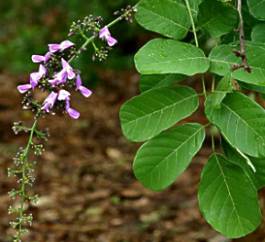
The tree has large compound leaves, greenish above and bluish green below, with 7 to 9 pairs of leaflets oppositely arranged, plus the terminal leaflet. From a distance the leaves resemble those of Pterocarpus rotundifolius. The shape of the leaflets varies from oval to elliptic-obovate. Leaves develop after flowering.
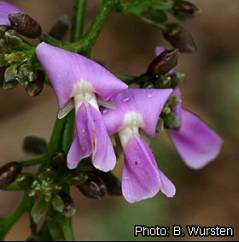
It flowers in early to midsummer, at the beginning of the rainy season, from November to January. Flowers are large, lilac to pinkish, on a long raceme up to about 35 cm long. This tree bears flat woody pods which are covered with velvety hairs and curl when dry to release the seeds.
Conservation Status
Status
Although Millettia stuhlmannii (muangaila) is currently listed as a species of Least Concern (LC) in the Red List of South African plants, this subpopulation faces imminent extinction due to poor regeneration and continuous root collecting for traditional medicine. Roots and bark can be found on sale at Thohoyandou, Sibasa, Musina and Louis Trichardt by traditional medicine street vendors for only R20 to R30 for half a cup of unprocessed bark and roots. A species count done in 2007 revealed that there were only 159 specimens left. Further research in propagation protocols is required in order to prevent possible extinction in the future through restoration programmes.
The traditional conservation model of using myths and taboos does not work due to economic pressures. Commercialisation has led to a collapse of the traditional conservation practices. Only residents of Ha-Makhuvha village still respect the traditional prohibitions but outsiders disregard the taboos and conservation myths.
In other African countries like Zimbabwe, Mozambique and Tanzania large specimens of this species are rapidly disappearing due to wood commercialisation.
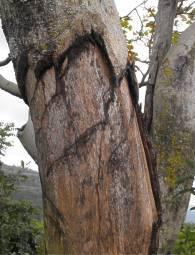
Distribution and habitat
Distribution description
In South Africa Millettia stuhlmannii (muangaila) is only found on top of a mountain at Ha-Makhuvha village. When the population was again assessed early in 2011 there was hardly a tree with a stem circumference below 30 cm.
This species is endemic to eastern tropical Africa. It is more abundant in Tanzania, Kenya, Mozambique and the eastern part of Zimbabwe on rocky hillsides in bushveld and deciduous forest. Only a small disjunct subpopulation of this tree is found in South Africa, restricted to 715-770 m above sea level.
It is one of three tropical African tree species found in South Africa only in small isolated localities in the eastern Soutpansberg mountain range. The other two are Brachystegia spiciformis and Brackenridgea zanguebarica.
Derivation of name and historical aspects
History
The genus Millettia is named after Charles Millet of Canton, China (circa 1830). The specific name stuhlmannii is named after Franz Ernst Stuhlmann, a collector of plants and an acting governor of the then Tanganyika currently known as Tanzania. The genus Millettia comprises 150 species of which 90 are on the mainland of Africa, 8 are endemic to Madagascar and 50 in tropical Asia. Based on molecular evidence the need exists to divide this genus into several genera.
Uses
Use
In other African countries like Mozambique, Tanzania and Zimbabwe the tree is highly commercialised for wood production. In Mozambique, muangaila provides the most wanted timber, but the volume of export trade is not known, as most trade is unregistered. The main importer is China. It is used for making furniture and sculptures. The wood is highly durable and is also used for flooring blocks. It is sold commercially under the trade name panga panga.
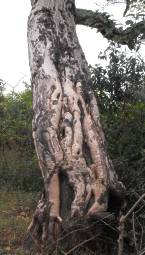
In South Africa, it is restricted to medicinal use and magical purposes. Root decoctions are drunk to treat many ailments affecting the stomach. The use of this tree for firewood or anything else, except for traditional medicine, is strictly prohibited through the application of myth and taboo. According to Siaga (2007), collecting is done by a dedicated member of the Makhuvha royal family or by an experienced traditional medicinal practitioner. There are prescribed rituals to be followed during the collecting of bark or roots for medicine which include smearing the leftover cool porridge on the roots. If this procedure is not followed it is believed that such bark will turn into venomous snakes which will bother household members of the collector. The collected material will lose its effect if the collection procedures are not followed. The late Chief Makhuvha also claimed that he could feel it if there were people intruding or illegally collecting this sacred tree.
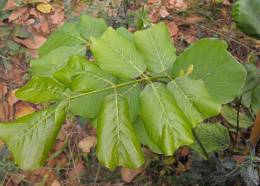
Growing Millettia stuhlmanni
Grow
It can be grown from fresh truncheons planted in the ground during the rainy period. Some locals in Tanzania plant sticks of muangaila to create a live boundary around their property. There is evidence of regeneration from suckers from the horizontal roots. The other way of propagation is through seed sown after treatment to break the dormancy by slightly roasting or soaking in hot water overnight. In South Africa, there has not been any horticultural attempt to propagate this tree. A population assessment that was done during April 2011 could not find any evidence of seed pods from this disjunct population at Vhembe District under Thulamela Local Municipality jurisdiction.
References
- Coates Palgrave, M. 2002. Keith Coates Palgrave Trees of southern Africa, edn 3. Struik, Cape Town.
- Glen, H.F. 2004. SAPPI What's in a name? The meaning of the botanical names of trees. Jacana, Johannesburg.
- Mutshinyalo, T.T., & Siebert, S.J., 2010. Myth as a biodiversity conservation strategy for the Vhavenda, South Africa. Indiliga: African journal of indigenous knowledge systems 9(2): 151-171.
- Raimondo, D., Von Staden, L., Foden, W., Victor, J.E., Helme, N.A., Turner, R.C., Kamundi, D.A. & Manyama, P.A. (eds) 2009. Red List of South African plants. Strelitzia 25. South African National Biodiversity Institute, Pretoria.
- Siaga, N.M, 2007. Population dynamics of Millettia stuhlmannii Taub. Population of Ha-Makhuvha, Vhembe district in Limpopo Province. Unpublished Honours Thesis. University of Venda, Thohoyandou, RSA.
- Van Wyk, A.E & Van Wyk, P.1997. Field guide to trees of southern Africa. Struik, Cape Town.
Credits
Thompson Mutshinyalo
Walter Sisulu National Botanical Garden
June 2011
Plant Attributes:
Plant Type: Tree
SA Distribution: Limpopo
Soil type: Brack/saline
Flowering season: Early Summer
PH: Neutral
Flower colour: Purple
Aspect: Full Sun
Gardening skill: Average
Special Features:
Horticultural zones







Rate this article
Article well written and informative
Rate this plant
Is this an interesting plant?
Login to add your Comment
Back to topNot registered yet? Click here to register.